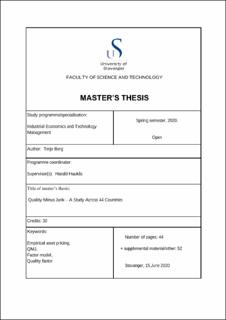| dc.contributor.advisor | Haukås, Harald | |
| dc.contributor.author | Berg, Terje | |
| dc.date.accessioned | 2020-10-12T08:41:48Z | |
| dc.date.available | 2020-10-12T08:41:48Z | |
| dc.date.issued | 2020-06-14 | |
| dc.identifier.uri | https://hdl.handle.net/11250/2682140 | |
| dc.description | Master's thesis in Industrial Economics | en_US |
| dc.description.abstract | This thesis seeks to further investigate the quality factor which is reported in the research literature on financial market anomalies and related to systematic investment strategies. The research is done first by a literature study, then by examining whether the findings from Asness, Frazzini and Pedersen’s paper “quality minus junk” [1] can be replicated when increasing the dataset from 24 countries to 44. The quality factor is a proxy based on an asset pricing model where the future discounted payoffs is split into separate terms relating to profitability, growth and safety. I provide evidence confirming two research hypotheses, namely that 1: There is a positive and significant relationship between price and quality, and 2: an abnormal risk-adjusted return can be earned by investing in high-quality stocks and shorting low-quality stocks.
The first finding on the positive relationship between price and quality shows that the model specification based on modern asset pricing has explanatory power on stock prices, but most of the cross-sectional variation in prices is still unexplained. This finding is true in 40 out of the 44 countries examined for the sample data between 2005 and 2019.
The second finding shows that a factor-mimicking portfolio (QMJ) going long on the highest quality firms and shorting the low-quality stocks earns a significant risk-adjusted return with a Sharpe ratio after hedging for other factor exposures just above 1. The risk-adjusted alpha was positive for 43 out of the 44 countries in the sample.
This thesis contributes the empirical asset pricing field by confirming the results from Asness et al. using a broad sample of 44 countries obtained from a different data provider and with all the factors built from scratch. In their paper they conclude the abnormal risk-adjusted returns of quality stock are due to mispricing and they are unable to find a risk-based explanation. This study supports those conclusions and I find that quality deliver consistent returns during times of distress as well as in times of boom. It is difficult to find a risk-based explanation of the abnormal returns or a behavior-based story for why investors underweight high-quality stocks. Rather, the intelligent investor should add the QMJ factor to his or her toolbox of factors which can be used to create a portfolio aligned with the investor’s goals and preferences. | en_US |
| dc.language.iso | eng | en_US |
| dc.publisher | University of Stavanger, Norway | en_US |
| dc.relation.ispartofseries | Masteroppgave/UIS-TN-IØSP/2020; | |
| dc.rights | Navngivelse 4.0 Internasjonal | * |
| dc.rights.uri | http://creativecommons.org/licenses/by/4.0/deed.no | * |
| dc.subject | industriell økonomi | en_US |
| dc.subject | empirical asset pricing | en_US |
| dc.subject | quality minus junk | en_US |
| dc.subject | QMJ | en_US |
| dc.title | Quality Minus Junk - A Study Across 44 Countries | en_US |
| dc.type | Master thesis | en_US |
| dc.subject.nsi | VDP::Samfunnsvitenskap: 200 | en_US |

